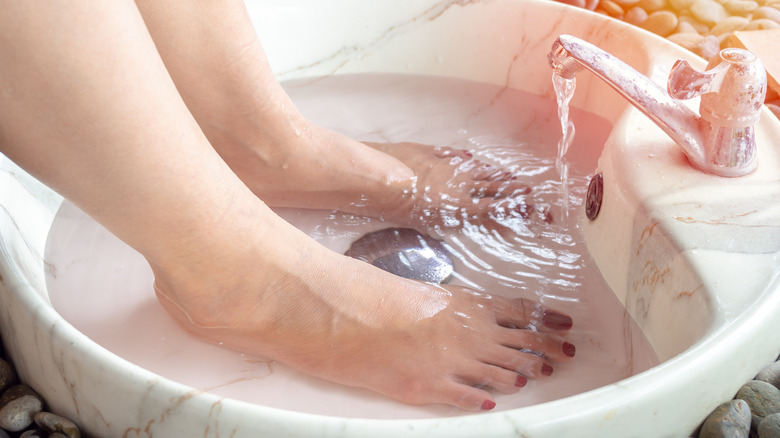How To Treat An Ingrown Toenail Using Epsom Salts
Ingrown toenails are among some of the most common reasons for a trip to the foot doctor. In fact, InformedHealth.org reports that for every 100 people who visit a podiatrist for a foot issue, 20 of them are affected by an ingrown toenail.
Characterized by redness, pain, and swelling, an ingrown toenail is the result of a nail that has grown into the surrounding skin. Also known as onychocryptosis, ingrown toenails can be sorted into one of three categories depending on how serious it is. The most severe cases will fall under stage 3, which is characterized by inflammation, discharge, and an overgrowth of skin over the nail.
Sweating is one risk factor in particular that can increase one's chances for developing an ingrown toenail. For this reason, young adults and adolescents going through puberty are often particularly susceptible to the condition. Wearing constricting shoes, over-trimming of the nail, or the presence of certain health conditions including diabetes, obesity, or heart or kidney failure are also potential risk factors.
An Epsom salt bath can help relieve inflammation from an ingrown toenail
While an ingrown toenail may not sound like an emergency, it's important to have it looked at in the event that you notice any early signs or symptoms. "Many people believe that ingrown toenails simply cause discomfort. But they can be the cause of infections," New Jersey-based podiatrist Velimir Petkov tells Allure.
While it's best to leave treatment of an ingrown toenail to a healthcare provider, some milder cases may benefit from certain home remedies in the meantime, such as an Epsom salt foot bath. "This will soften your skin and reduce any inflammation," Dr. Petkov told Allure.
To do so, create a warm water solution mixed with Epsom salt and soak your feet for a period of 10 to 15 minutes twice daily. Even better, follow up your foot soak with a gentle massage to further decrease inflammation and boost blood flow (via WebMD). Last, use a towel to dry the area and dab on some antibacterial cream.
Treatment and prevention for ingrown toenails
If symptoms persist for more than seven days despite your best foot soaking-efforts, be sure to see a podiatrist. The same is true if you notice swelling, redness, or pus oozing from the area (via WebMD). It's also important to consult your doctor if you have diabetes or suspect a fungal nail infection. In some cases, prescription medication or partial removal of the nail may be necessary. In the event that an ingrown toenail is accompanied by fever or the development of red streaks on the skin surrounding the toe, seek immediate medical care.
While our genes can also play a role in whether or not we're more likely to develop an ingrown toenail (via Allure), there are measures we can still take to help minimize our chances, such as practicing proper foot hygiene. This includes wearing properly fitted socks and shoes, regularly washing and drying your feet, and keeping feet protected against injury (per WebMD). Finally, when it comes time to cut your toenails, be mindful not to trim the nail into a rounded shape. Rather, keep things even and cut a horizontal line straight across the top of the nail.



